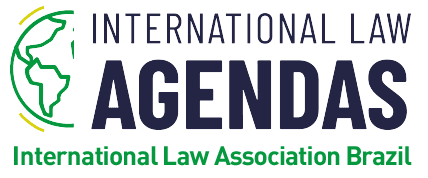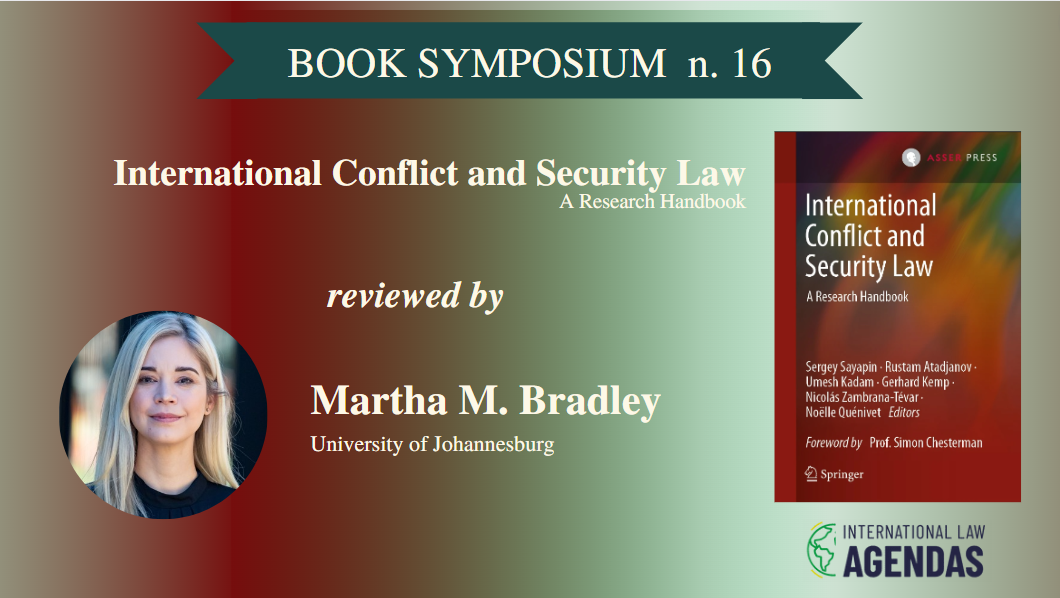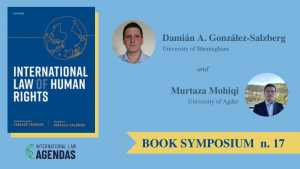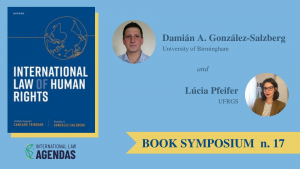I am delighted to review the work International Conflict and Security Law: A Research Handbook | SpringerLink edited by Sergey Sayapin, Rustam Atadjanov, Umesh Kadam, Gerhard Kemp, Nicolás Zambrana-Tévar, Noëlle Quénivet. This contribution, in the context of IHL, covers topics often overlooked, such as The Status of Forces Agreements | SpringerLink),Military Space Operations | SpringerLink, The Protection of the Environment and Natural Resources in Armed Conflict | SpringerLink. The work grapples with challenges that are present during contemporary armed conflicts that aggravate the fighting or, as a consequence of armed conflict, worsen the effects of climate change (Climate Change and Armed Conflict | SpringerLink) and poverty( Poverty | SpringerLink).
The 2019 ICRC Challenges Report specifically flags as a theme requiring academic scrutiny the effects of armed conflict on the climate and the environment (4427_002_ International Humanitarian Law and the Challenges of Contemporary Armed Conflicts – Recommitting To Protection In Armed Conflict On The 70th Anniversary Of The Geneva Conventions; 10.2019; 500 (icrc.org)). The Challenges Report highlights: ‘The environment is frequently one of the casualties of war – but the damage is often not visible and environmental damage tends not to be the priority of warring parties. A certain amount of environmental harm is inherent in armed conflict, but it cannot be unlimited.’(ICRC 2019 Challenges Report 67) This Research Handbook takes up the challenge in thought-provoking contributions in The Protection of the Environment and Natural Resources in Armed Conflict | SpringerLink, (Climate Change and Armed Conflict | SpringerLink) and (Military Ecocide | SpringerLink.
The reality in Africa is the experience of non-international armed conflict (NIAC) (most contemporary armed conflicts), indeed, it was refreshing to discover the authors have given much needed and in-depth attention to the law of non-international armed conflict (LoNIAC) in addressing IHL topics. LoNIAC and NIAC often appear to be the product of an afterthought; a paragraph as the conclusion to a thematic IHL chapter where they are dealt with summarily. The editors and authors of this publication carefully and systematically engaged with NIAC and LoNIAC throughout this work. In my opinion it is a valuable resource for those operating in the area of NIAC or are concerned with LoNIAC.
In respect of the value of this work, I comment on especially two chapters. First, ‘Jihad Misplaced for Terrorism: An Overview of the Boko Haram Crisis from Islamic and International Humanitarian Law Perspectives | SpringerLink by Muhammad-Basheer A . Ismail and, second, the chapter on War Crimes | SpringerLink by Ewa Salkiewicz-Munnerlyn and Sergey Sayapin.
‘Jihad Misplaced for Terrorism: An Overview of the Boko Haram Crisis from Islamic and International Humanitarian Law Perspectives’ by Muhammad-Basheer A. Ismail
The 2019 ICRC Contemporary Report flags the applicability of International Humanitarian Law (IHL) to states fighting organised armed groups designated as terrorist organisations(4427_002_ International Humanitarian Law and the Challenges of Contemporary Armed Conflicts – Recommitting To Protection In Armed Conflict On The 70th Anniversary Of The Geneva Conventions; 10.2019; 500 (icrc.org) 59). Three specific challenges are flagged. First, often states deny the existence of non-international armed conflict on their territory and label the organised armed groups as terrorists. Second, there is a tendency to consider conflict-related violence as acts of terrorism. Lastly, in some cases, states assert that organised armed groups they have designated as terrorists to trigger an exceptional/ counter-terrorism response which is not constrained by IHL. (ICRC 2019 Challenges Report 59) The consequence of this inaccurate use of ‘labels’ is that it limits the application of IHL; the appropriate legal framework for situations of NIAC.
Terrorists in committing terrorist acts are regulated by national law and not IHL. An organised armed group which is party to a non-international armed conflict is bound by IHL regardless of the label as a terrorist group. Of course, terrorist cells may operate alongside organised armed groups and who affiliate with the terrorist cells. When these groups commit violent attacks during an armed conflict there is a question whether they should be considered as terrorist or as organised armed groups under international humanitarian law. This dilemma is not a theoretical debate but is a critical reality to situations in the Middle East and in Africa, for example in Cabo Delgado where Al-Shabab, an Islamic State affiliate group, is labelled as terrorist by the Mozambican government and by other states.
Often overlooked in discussions is the role of religion and jihad as complications. The contribution titled ‘Jihad Misplaced for Terrorism: An Overview of the Boko Haram Crisis from Islamic and International Humanitarian Law Perspectives’ by Muhammad-Basheer A. Ismail addresses this contemporary challenge and provides a thoughtful reflection on the interconnection between IHL, international law and Islamic Law of Jihad as illustrated through the activity of Boko Haram in Nigeria.
Ismail observes: “The two terms ‘terrorism’ and ‘jihad’ have, in the past few decades been given a synonymous meaning by some commentators due to the prevailing internal conflicts in most Muslim States. The perception of jihad and terrorism needs to be properly contextualised in their distinct perspectives so that one does not wallow endlessly in the murky cesspit of this misconception.” (Jihad Misplaced for Terrorism 1395) Ismail weighs up the circumstances whether to evaluate Boko Haram exclusively as a terrorism faction or if it meets the organisational criteria to qualify as an organised armed group. As well, he aims to establish if the fighting between Boko Haram and the Nigerian Armed Forces equates to protracted armed violence in order to determine if the law of non-international armed conflict is applicable. Ismail defines the term ‘jihad’ and tests whether Boko Haram is engaged in jihad. This is a seminal interrogation of legal definitions (or the lack thereof) applied to terrorism, jihad and internal armed conflict and the differing legal framework each triggers, employing Boko Haram as an illustration. Ismail attempts the classification of fighters labelled terrorist or jihadist and analyses the neglected connection between jihad and the Islamic Law of IHL. This contribution is of great assistance to those tasked with conflict classification, including military legal advisors, policy makers, non-governmental and humanitarian organizations.
The section that covers the overlap between the basic principles of Islamic Law of Jihad and the basic principles of IHL is a novel addition to the body of literature (Jihad Misplaced for Terrorism para 6.1.4). Ismail unpacks the vesting of the principles of military necessity, distinction, proportionality and humanity in the Islamic law of jihad. His analysis is of service to those organisations (Geneva Call comes to mind) who engage with Islamic organised armed groups with the aim of encouraging them to honour IHL. Their purpose is to promote a sense of buy-in and the realisation that IHL is not merely a Western legal system that is imposed by their enemy.
‘War crimes’ by Ewa Salkiewicz-Munnerlyn and Sergey Sayapin
Though IHL and ICL are separate fields of public international law, their close relationship is to found in the sphere of war crimes – a war crime, essentially, is a serious violation of IHL that triggers individual criminal responsibility under ICL. From the ICL perspective, IHL serves as a point of reference for the understanding and interpretation of the corresponding war crime provision (An Introduction to International Criminal Law and Procedure | Higher Education from Cambridge 15). An ICL-centric lens generates differing interpretations – the interpretation of the notion of ‘attack’ in Ntaganda and the contemplation of the possibility of intra-party protection, also in Ntaganda, are cases in point (Prosecutor v. Ntaganda, Case No. ICC-01/04-02/06 A A2, Appeals Chamber Judgment). Sassóli has reminded us that IHL is not “an auxiliary science” of ICL (sometimes considered to be the case from an ICL point of view) (International Humanitarian Law – Rules, Controversies, and Solutions to Problems Arising in Warfare | Elgar Online: The online content platform for Edward Elgar Publishing 444). It is rather that IHL relates to ICL in that ICL either enforces IHL or clarifies rules or concepts in IHL (Sassóli 444). The authors of ‘War Crimes’ do not treat IHL as an ‘auxiliary science’ to ICL but engage with the topic of war crimes by displaying a balanced approach firmly based on an understanding of IHL.
Salkiewicz-Munnerlyn and Sayapin sort war crimes under four categories: War Crimes against Protected Persons; War crimes against Protected Objects; War Crimes Related to Unlawful Methods of Warfare and War Crimes Related to Unlawful Means of Warfare. This grouping is accessible to those familiar with IHL. Throughout, the subject of war crimes committed in the context of NIAC is addressed. Most welcome is the clear assertion of the distinction between who are classified as ‘perpetrators’ and who are ‘victims’. The section on the classification of ‘victim’ of a war crime specifically addresses the difference in approach between a non-international armed conflict and an IAC in respect of the nationality requirement:
The situation is different in NIACs, because the nationality approach does not affect the application of the concept of war crimes in internal armed conflicts. In NIACs, the law of war crimes applies to members of a state’s armed forces or organised armed groups and their adversaries sharing the same nationality. Article 3 …provides protection to “[p]ersons taking no active part in the hostilities including members of the armed forces who have laid down their arms and those placed ‘hors de combat’ by sickness, wounds, detention or any other cause
(War Crimes 1104)
The emphasis that ‘protected’ persons relates to categories explicitly cited in Common Article 3 – a clear comprehension of who is the perpetrator and who is the victim for purposes of war crimes committed during NIAC – is critical. International criminal courts and tribunals, at times, confront the question whether a member of an armed group may be a victim in the commission of a war crime by members of the same armed group. This chapter provides guidance on the nature and categories of war crimes as well as who can be charged with the commission of war crimes and who qualify as victims of war crimes. Not only is the contribution accessible, but it is a response to a greatly-needed clarification as to the content and contours of the law relating to war crimes.
This volume, from a variety of regional perspectives, provides a comprehensive examination of key issues and themes that relate to the jus ad bellum, the jus in bello and to international criminal law. Many university library collections experience budgetary constraints and this work provides value in addressing pressing contemporary issues that relate to International Conflict and Security Law. It is serviceable for postgraduate courses concerned with IHL/ ICL and other issues of international security law and is a sterling resource for researchers, academics and legal advisors.
-

Martha M Bradley is Associate Professor in the Department of Public Law, Faculty of Law, University of Johannesburg. She specializes in Public International Law and International Humanitarian Law. Professor Bradley is a Y1 National Research Foundation rated Scholar.





